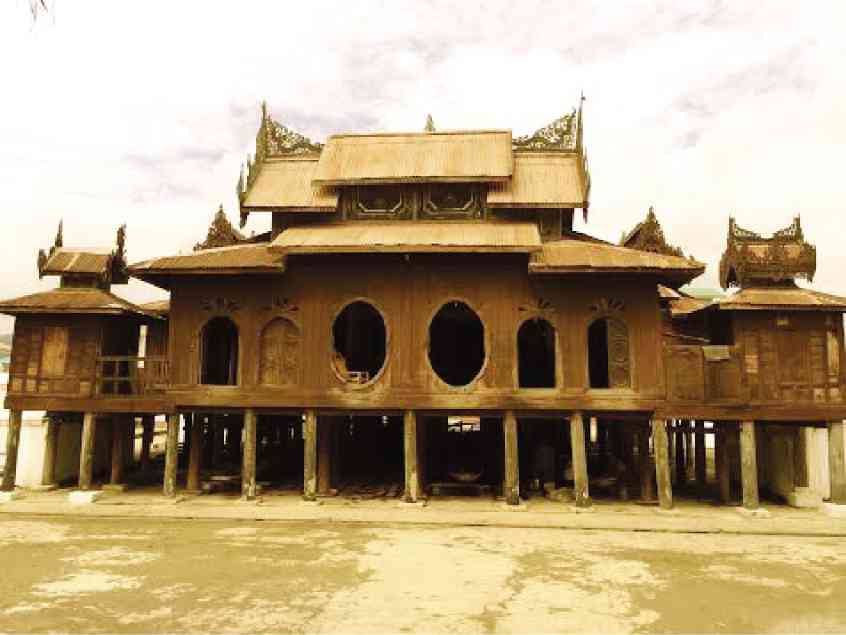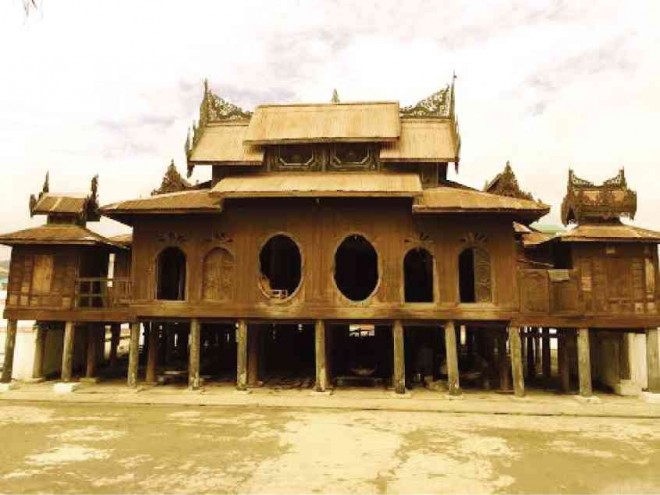
In the past, Burma (Myanmar) had always been a verboten destination. Military repression in decades of general’s rule on Burmese people was a reason not to visit.
The interest remained and we followed goings-on in the country that has been renamed Myanmar. We empathized with the Burmese, having experienced what it was like under martial law. Reading “Burmese Days” by George Orwell, “From the Land of the Green Ghosts” by Pascal Khoo Thwe, “Following George Orwell’s Footsteps” by Emma Larkin and “The Lady and the Peacock: The Life of Aung San Suu Kyi of Burma” by Peter Popham, equipped us with knowledge needed to appreciate the country and its people and history.
On a visit to Chiang Mai in 2002 to research on Thailand’s Royal Project, Prince Bisatej, the King’s cousin, warned us against stepping into Burmese territory. We just peeked through a locked gate that divided both countries and saw Burmese soldiers on the other side. We told ourselves that one day, we would step foot in forbidden land.
The right time came last year. Our visit corrected some misconceptions we had about the country.
We noticed many foreigners on the flight and when we landed in Yangon, not a soldier was in sight. We passed the long visa lines, enjoying the privilege of entry permits granted to Filipinos.
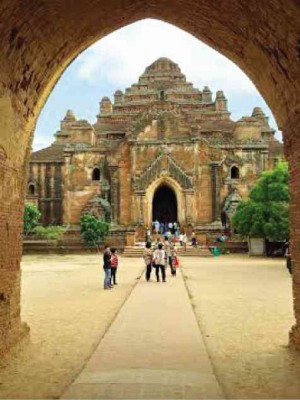
400-percent tax
Yangon was bustling and vibrant. There were many new Japanese-brand cars on the road and several big car displays.
Tax on cars used to be 400 percent but this was lowered in 2010 to 100 percent resulting in an influx of cars on the road and traffic. President U Thein Sein initiated some reforms, such as the lowering of taxes and costs of basic commodities.
Political reforms were also instituted; the National League for Democracy (NLD) was finally allowed to participate in the midterm elections. Of 45 contested seats, the NLD won 43 seats, ushering the entry of Aung San Suu Kyi in mainstream politics.
As we went around we saw posters and calendars of democracy icon Aung San Suu Kyi widely displayed in shops, in the markets and in homes. She is referred to as “The Lady” and we learned during our two-week travel how well-loved and revered she was.
We drove by her house on University Avenue and dropped in the headquarters of the NLD where her books and other souvenirs were sold.
Strand Hotel
The landmark in Yangon is the Shwedagon Pagoda, built 2,600 years ago. Like Napoleon’s tomb in Paris, Shwedagon shines at night.
This pagoda is believed to house the relics of the four buddhas and pilgrims come with offerings of water for peace, flowers for beauty, incense for reputation and candles for wisdom.
Some of the buildings built by the British still stand, including the Strand Hotel built in 1901.
During World War II, Japanese troops were quartered here and after the war the Burmese became part of the hotel’s clientele. As we sat for coffee, we thought, “if only walls could speak.”
Scott Market
An attraction in Yangon is the Scott Market, where one finds the largest collection of souvenirs, gems, jewelry, silk and cotton weaving, lacquer ware and crafts, which later we would find being produced in many parts of the country.
One discovery was thanaka, the Burmese national makeup. It is a white-yellowish powder or paste derived from the bark of a tree, ground on a stone slab.
Aside from its cosmetic use, thanaka protects one against the sun, cools the skin and keeps mosquitoes at bay. The Burmese apply it on the cheeks and foreheads, making them look like they’re wearing a mask or a layer of foundation. Men use it too in the summer to cool their skin.
From Yangon, we flew to Bagan, the country’s top tourist destination, a must-see. It is an ancient city and a rich archeological site.
It was the capital of the Pagan Kingdom from the 9th to the 13th centuries. Bagan became the seat of power under the rule of King Anawrahta; it was then that the regions were unified to constitute Burma.
Bagan is on the eastern banks of the Irrawaddy River.
Known as the “temple town,” it is home to over 2,300 Buddhist pagodas, temples, stupas and ruins—all within 16 square miles. It was explained that the shape, design and structure of each building had spiritual symbolism.
Under the hot Burma sun, we went temple hopping, paying homage to religious sites.
The day started with a visit to the Nyaung U Market. Then we took time to visit eight temples, making offerings and praying along the way.
There were the Shwezigon Stupa; Wetgyinn Gubyaukgyi Temple; Htilominlo Temple; Kheminga Temple Group; Ananda Temple; Thatbyinnyu, the highest temple; Dhammayangyi, the biggest temple; and finally, the Shwesandaw Stupa, where we enjoyed a 180-degree panoramic view and a beautiful sunset.
Giant river
From Bagan, we went on the Pandaw Cruise and sailed upstream on the Irrawaddy River to Mandalay. The ship is made of teakwood and is 192-foot long and 29-ft wide. An efficient all-male staff attended to our every need. A French woman supervised the cooks preparing each meal.
For seven days, we were in community with 20 other guests from England, Ireland, Italy, Malaysia, Singapore and Australia.
On deck we dined al fresco, the wind brushing against our faces. Activities and shows were held on board, sessions on Burmese culture, Buddhist life and how to wear a longyi and apply thanaka. There was a Burmese puppet show and classical ballet was performed by the Mandalay University students.
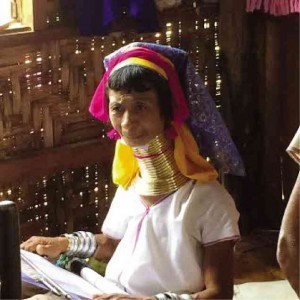
known for wearing copper neck rings
Sailing on Burma’s largest river took us through the country’s backwoods. We seemed to have taken the road less traveled, passing by settlements and different landscapes.
Our daily excursions brought us to communities that were centers of weaving, terra-cotta pottery, silver workshops and market visits, giving us insights on the Burmese way of life.
These included Pakokku Market, a morning walk in Yandabo where pottery was produced using river clay, Ava and Amarapura ancient “immortal” cities, a walking tour of Mingun to visit the brick pagoda and largest bell in the world, and New Nyein Village where the famous 50 gallons handmade water pots were glazed.
We caught sight of the famous U Bein Bridge, said to be the world’s longest teakwood bridge. Under the bridge, in small boats, we sailed on Taungthaman Lake and enjoyed the golden sunset.
400,000 monks
Mandalay is the center of education, Burmese culture and Buddhist learning. The country is steeped in Buddhism, the practice that is prevalent in their daily lives.
Sagaing Hill is considered the country’s spiritual hub, with 600 pagodas, 3,000 monks and 100 meditation centers.
Burma is estimated to have 400,000 monks and 100,000 nuns undergoing training.
People are devout Buddhists and their belief in karma yields the discipline and the collective attitude of light living and the acceptance of circumstances.
Most interesting
After a week on the Irrawaddy, we were transported to another kind of existence in Lake Inle.
In the Shan State Hills, the lake is 21.7 kilometers long and 11 kilometers wide and is almost 3,000 ft above sea level. The backdrop of Inle Lake are mountain ranges and cloud formations. Here was most interesting and the high point of our Burma experience.
There are 100 villages around the lake inhabited by the Intha with a mixture of Shan ethnic groups, such as the Pa-O, Taung Yo, Danaw, Danu and Kayah. They live in wooden houses on stilts above the water.
Their livelihood comes from fishing and agriculture. They tend to floating gardens anchored on bamboo poles.
The transportation systems around the lake are motorized canoes or flat-bottom bancas propelled by a single wooden paddle rowed by foot. The boats traverse the lake’s tributaries.
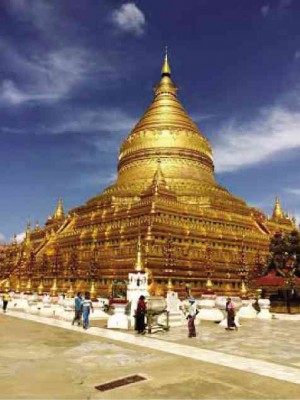
and stupas are found all over Burma
Around the lake is a community that thrives on crafts such as weaving, metalwork, pottery, tools making, and produces vegetables, silver and cheroots.
The lake people are self-sufficient.
We visited weaving workshops and were amazed on how they controlled the process using simple apparatus. They grew the cotton, silk and lotus, and processed these into thread, dyeing the colors desired before weaving.
Weaving is a tradition that has been kept alive throughout the country and produces fabrics for the locals’ daily use, including the longyi for men.
Once a week, people on boats head to a village where a market is set for a day. Here they trade bamboo and cattle and sell products wholesale.
We saw a woman selling yellow chick-pea tofu and in other stalls, a variety of chili and spices and condiments, betel nut, woven cloth, medicines and vegetables. There was a handsome couple selling gemstones.
Food stalls were put up and cauldrons of dishes were offered, among them curries. These were served with steamed rice wrapped in lotus leaves that also served as plate.
We tried their rice wine but it tasted more like our lambanog sugarcane wine.
Negotiating the canals, we passed homes and several stores, restaurants and pagodas on stilts as well. There was an array of Burmese meals offered, dishes of freshwater fish and shrimp, pork and beef and salads of tea leaves, beans, glass noodles, crackers and tomatoes in lime and fish paste patis, curries and fresh seafood.
It was hot, the fierce sunlight beating on our head. But we felt the chilly wind on the boat rides crossing the lake, and experienced the cold in the evening.
Our last days by the lake provided time for reflection and for review of our travel. We felt appreciation for the Burmese people and our kinship with them.
Tourism in Burma is a big potential. They are now looking to develop environment destinations.
But the reality is, the inflow of tourists is dependent on political conditions and to an extent, nature.
The Burmese feel hopeful. Through tourism, they are opening up. It can be good. It can be bad.

